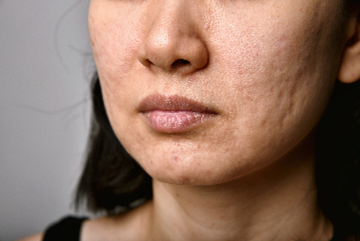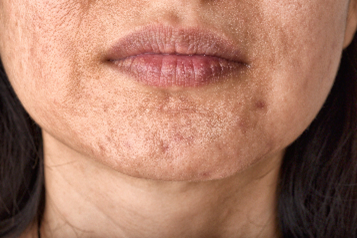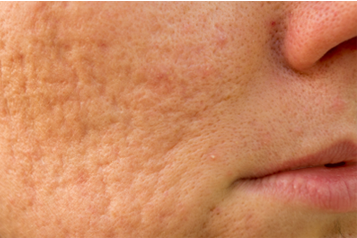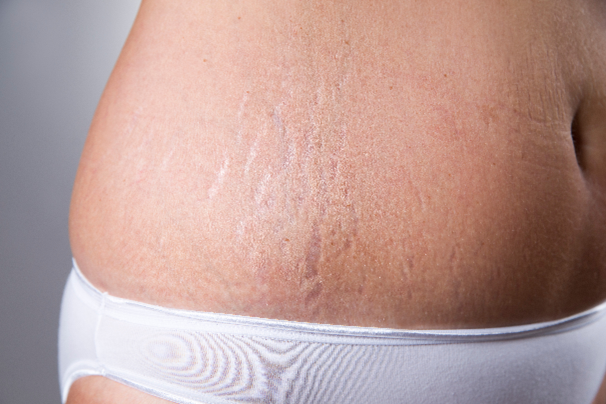Scarring and Stretch Marks
Scars | Acne Scarring
Scars
A scar is the way the body heals naturally by replacing damaged or lost skin
What are Scars?
A scar is the way the body heals naturally by replacing damaged or lost skin. The skin repairs itself by growing new tissue that pulls the wound together and fills in any gaps caused by the injury. Scar tissue is made primarily of a protein called collagen. Scars can appear anywhere on the body, and the composition of a scar may vary. A scar may appear flat, lumpy, sunken, or coloured. It may be painful or itchy. The final look of a scar depends on many factors, including the skin type and location on the body, the direction of the wound, the type of injury, age of the person with the scar, and his or her nutritional status. They form for many different reasons, surgery, injuries, infections, or inflammation of the tissue.
Scarring on skin types darker than a Fitzpatrick level 3 may also present with red or brown discolouration called Post inflammatory Hyperpigmentation. If untreated, in most cases, the pigment will lighten on its own however this may take 6 – 12 months.
Your scarring will be assessed by a dermal therapist which will determine the best treatments for your desired outcome.
Types of Scar
- Keloid
These scars are raised above the skin’s surface, lumpy and spread beyond the wounded area. The overgrown scar tissue can get large and may affect movement. They often appear red or darker in colour, as compared to the surrounding normal skin. Keloids are formed from over production of collagen or the collagen hardening after a wound has healed. These scars may appear anywhere on the body. In most cases Keloid scarring will be avoided and not treated in clinic. - Hypertrophic
Unlike Keloid scars hypertrophic scars growth is confined within the boundaries of the wound and may be more responsive to treatment. These scars may also look red, and are usually thick and raised. Hypertrophic scars usually start to develop within weeks after the injury to the skin. Hypertrophic scars may improve naturally. But this process may take up to a year or more. You can feel a hypertrophic scar when you run your finger over it. These raised scars may get smaller over time, but they never completely even or flatten out.
- Contractures
Often developing after a burn Contractures are an abnormal occurrence that happens when a large area of skin is damaged and lost, resulting in a scar. The scar formation pulls the edges of the skin together, causing a tight area of skin. The decrease in the size of the skin can then affect the muscles, joints, and tendons, causing a decrease in movement. - Depressed (atrophic)
Also called ice pick scars, These sunken scars often result from chickenpox or acne. They look like rounded pits or small indentations in the skin. They develop most often on the face. Acne scars may become more noticeable as you age because the skin loses collagen and elasticity over time. - Flat
Flat scars are often pink or red. Although it may be slightly raised at first, this type of scar flattens out as it heals over time, they may become slightly lighter or darker than the surrounding skin.
Book Now
Get in Touch
Opening Hours
| Monday | CLOSED |
| Tuesday | 9.00AM - 5.00PM |
| Wednesday | 9.00AM - 5.00PM |
| Thursday | 9.00AM - 6.00PM |
| Friday | 9.00AM - 5.00PM |
| Saturday | 9.00AM - 2.00PM |
| Sunday | CLOSED |
Later appointment times in the evening are available by booking in advanced only.
You will find us at Stargate Shopping Centre
Shop 9, 49 Chelmsford Avenue
Port Kennedy
6172 WA
Acne Scarring
Acne causes inflammation in and under the skin. This injures the skin which then responds by laying down new collagen to heal the injury. Unfortunately scars can heal by fibrosis which tightens and pulls the skin, leading to depressions and holes at the site of the scar.
Types of acne scarring
The following types of scar occur in acne, true acne scarring will never fully go away but great improvements can be made to the appearance with the correct course of treatments and homecare
-
- Ice-pick scars – these are deep, narrow, pitted scars
- Rolling scars – broad depressions with a sloping edge
- Boxcar scars – broad depressions with sharply defined edges
- Atrophic scars – flat, thin scars or depressed scars (anetoderma)
- Hypertrophic or keloid scars – thick lumpy scars.



What are stretchmarks?
Stretchmarks are scar like streaks that appear over the skin. Early stretch marks are usually red or purple. Over time, stretch marks lose their colour and become white or silvery in appearance. The tissue under the skin expanding is the most common cause and usually develop during growth spurts in adolescence/puberty and during pregnancy. They can also occur in body builders and as a consequence of rapid weight gain and in some medical conditions where the skin is exposed to excess amounts of a hormone called cortisol.
Stretch marks naturally fade and usually become less obvious over time. All of our light therapies can aid in improving the appearance of stretch marks. A combination of IPL MAX G, 1540 and PicoSure (link to treatment pages)laser delivers great results. Your stretch marks would be assessed and patch tested before treatment.

